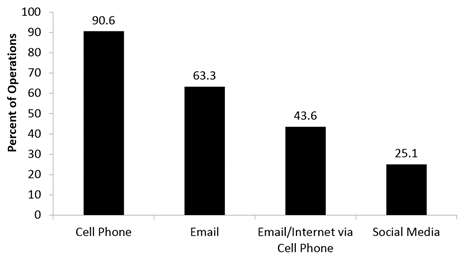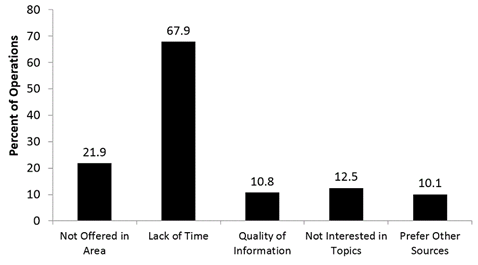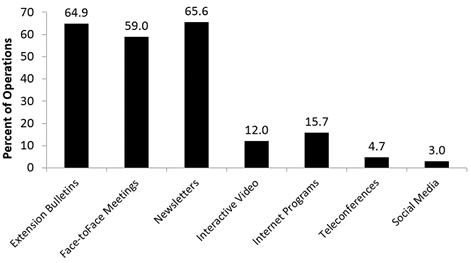 |
December 2014
|
December 2014 // Volume 52 // Number 6 // Research In Brief // v52-6rb7
The North Dakota Beef Industry Survey: Implications for Extension
Abstract
A portion of the North Dakota Beef Industry Survey was developed to determine how educational programs can evolve to meet future needs of North Dakota beef producers. Of the 2,500 surveys mailed out to beef producers, 527 responses were completed and returned. Results highlight the level of education of North Dakota beef producers, anticipated use of technology in the next 1 to 5 years, educational meeting attendance, and preferred methods of receiving educational programming. Future programming efforts should be developed and delivered using a multi-faceted approach to ensure acceptance and utilization by producers with varying degrees of technology reliance.
Introduction
The landscape of Extension is changing from both a funding and technology standpoint (Mirando et al., 2012). As Extension changes and prepares for the future, it is of the utmost importance that Extension personnel are aware of their clientele's previous experiences, perceptions of current programs, and how program delivery may need to be adapted in the future (Adedokun, Parker, Loizzo, Burgess & Robinson, 2011).
As technology continues to evolve, Extension personnel will be faced with the process of adapting program delivery to new technologies (Ezell 1989). A task force charged with preparing counties for future technology adoption stated that "time is of the essence if Extension is to thrive in the digital age" (Diem, Hino, Martin, & Meisenbach, 2011). Whereas some segments of clientele may adopt technology at high rates, other segments may be totally excluded from technology use because technology is either not available (Harder, Moore, Mazurkewicz, & Benge, 2013) or clientele prefer more traditional means of communication (Vanderford, Gordon, Londo, & Munn 2014; Boone, Sleichter, Miller & Breiner, 2007). In addition, preferred methods of communication can be influenced by age demographics, level of education, and access to technology (Howell & Habron, 2004).
To aid in development of appropriate future programs, a portion of a broad-based survey effort of North Dakota beef producers was dedicated to understanding the age demographics and education level of survey respondents, anticipated use of technology in the next 1 to 5 years, educational meeting attendance, and preferred methods of receiving educational programming.
Methods
Preliminary survey questions were developed in consultation with and vetted by a stakeholder group that included members of the North Dakota State University Extension Service, North Dakota (ND) Beef Commission, ND Stockmen's Association, ND Corn Council, ND Soybean Council, ND Bankers Association, ND Department of Agriculture, and independent beef producers to ensure input from all stakeholders was considered. In addition, a pilot survey was administered to a focus group of beef producers to ensure question clarity and appropriateness of multiple choice response options.
All survey questions and methodology were approved by the North Dakota State University Institutional Review Board.
A total of 2,500 surveys were printed and sealed, then delivered to the National Agriculture Statistics Service's (NASS) North Dakota field office. Personnel at NASS randomly selected names of 2,500 North Dakota beef producers (>25% of current beef producers) to receive the prepackaged, return postage-paid surveys. Response to the survey was voluntary, and researchers had no knowledge of who received the survey mailings or who returned completed surveys. An additional survey packet was sent to all recipients 2 weeks after the initial mailing as a reminder with instructions to disregard the survey if recipients had already completed the initial survey.
Completed surveys were returned to researchers for data entry. A total of 527 surveys were completed and returned (21.1% response rate), and the 436 responses (82.7%) that came from respondents self-identified as active beef producers were used for subsequent analysis. Means and frequencies of data responses were analyzed using SAS version 9.3.
Results and Discussion
Commercial cow-calf production was present on 94.5% of operations completing the survey. Seventy-two percent of the principal operators filling out the survey were over the age of 50, and 80.4% of respondents have been beef producers for over 20 years. In addition, 97.9% of the principal operators were male. This population demographic is in stark contrast to the large proportion of female students (70%) attaining bachelor's degrees from animal science departments (Esbenshade, 2007). The trend of increasing number of females studying animal sciences (Buchanan, 2008) may result in a similar shift in the demographics of beef producers. A survey of Extension educators revealed a perception that the educational needs of female audiences are different than those of male audiences (Brasier et al., 2009). In addition, some authors recommended that programs be developed specifically for female audiences (Rivera & Corning, 1990). Thus, if further queries identify that more females are planning on entering the beef industry there could be substantial merit in targeting novel Extension programs to young females.
Understanding the level of education of a target audience is paramount to delivering programming appropriate for that particular audience (Miller, 2001). The largest proportion of respondents in the current survey reported a high school diploma as their highest level of education attained, followed by bachelor's degree, associate's degree, other, and graduate degrees (Figure 1). In a survey of beef and peanut farmers, higher levels of education were related to earlier adoption of technology (Hall, Dunkelberger, Ferreira, Prevatt, & Martin, 2003). The diversity in educational background in respondents to the current survey highlights a need for programs to be delivered clearly and at a level that will ensure comprehension by all audiences.
Figure 1.
Highest Level of Education Attained by Principal Operator

A question was developed to evaluate plans for technology use over the next 1 to 5 years. As technologies become more advanced (e.g., moving from having a cell phone to using social media; Figure 2) fewer producers were likely to use them. For example, 90.6% of producers indicated they were likely to use cell phones, 63.3% were likely to use email, 43.6% were likely to access email and/or Internet via a cell phone, and 25.1% were likely to use some type of social media in the next 1 to 5 years. The proportion of producers in our survey who plan to use cell phones and access the Internet or email via cell phones is similar to other producer populations surveyed (Walter, 2011).
Interestingly, McCutcheon and Boyles (2007) reported that 99% of livestock producers in an intensive training session felt that using handheld computers would make record keeping easier, and a population of potato farmers surveyed used email and social media to a greater extent than our population of beef producers (Guenthner & Swan, 2011). A possible reason for lower use of Internet via cell phones in the current report may be the lack of infrastructure to support such activity in remote rural areas (Broadband ND, 2012). But clearly there are segments of the producer population that are much more likely to use computers than the sample represented in our survey. However, our sample is likely representative of the current population of active beef producers, and the technology use patterns may change when we move past the 5-year window specified in our survey questions.
Figure 2.
Technologies Likely to Use in the Next 1 to 5 Years.

When asked about involvement in 4-H, FFA, or other agriculture-related youth groups during their childhood or youth, 63.3% of respondents indicated that they were involved in such groups as a youth member. In addition, 65.6% of respondents indicated that their involvement in agriculture-related youth organizations influenced their interest in pursuing a career as a beef producer. Therefore, youth programs have the potential to attract and inspire youth to become future beef producers. Similarly, a survey of 4-H alumni revealed that 4-H not only influence their career choice, but also their area of focus for advanced education and the institute at which they studied (Rockwell, Stohler, & Rudman, 1984). In addition, further participation in 4-H councils influenced career goals and leadership ability (Boleman, Merten, & Hall, 2008).
At least one educational meeting was attended by 82.5% of our survey respondents. Specifically, 16.8%, 26.3%, and 39.3% of respondents indicated that they attend one, two, or three+ educational meetings annually, whereas 17.5% indicated they do not attend educational meetings. It is important to note that the meeting attendance is not confined to meetings sponsored by NDSU Extension. Lack of time was the most frequently cited reason reported for not attending NDSU Extension meetings, followed by meetings not being offered in producers' area, lack of interest in the topic, quality of information presented, and a preference for other sources of information (Figure 3). As programs are developed it is important to be sensitive to the opportunity cost of time for potential meeting attendees and offer the most impactful programs possible.
Figure 3.
Reasons for Not Attending NDSU Extension Meetings.

Educational programs can be delivered in a variety of methods that allow producers to access information at their leisure. Extension newsletters, bulletins, and Internet programs all allow producers flexibility regarding when they actually review information. Preferred methods of educational information delivery included face-to face meetings, newsletters, and bulletins compared with programs recorded on the Internet, interactive video, teleconferences, and social media (Figure 4). As we proceed into developing Extension programs of the future, technology will likely become more important as a means to reach more people with fewer resources (Mirando et al., 2012). Results of the current report, however, reinforce the need to maintain the use of traditional methods of program delivery to satisfy current clientele. Similarly, Vergot, Israel, and Mayo (2005) reported Extension newsletters and bulletins as preferred channels of information for Florida beef producers, whereas Internet web sites were the least preferred of the options presented.
Figure 4.
Methods of Educational Programming that Producers Indicated They Would Most Likely Get Information From.

Conclusions/Recommendations
The current report offers insight into providing Extension education for current beef producers in North Dakota, with implications for other states as well. Beef producers are a dynamic group with a broad range of educational backgrounds, anticipated technology use, and interactions with Extension. Our interpretation of the survey results highlight the need to:
- Deliver programs that are appropriate for or tailored to a variety of educational backgrounds.
- Continue to implement agriculture-related youth programs to foster and encourage interest in pursuing careers in agriculture.
- Be sensitive of time commitment required for programs and offer the most impactful programs possible.
- Do not lose sight of the value that "traditional" program delivery avenues have in meeting the educational needs of current producers.
References
Adedokun, O. A., Parker, L. C., Loizzo, J., Burgess, W. D., & Robinson, J. P. (2011). Factors influencing participant perception of program impact: Lessons from a virtual fieldtrip for middle-school students. Journal of Extension [On-line], 49(6) Article 6FEA8. Available at: http://www.joe.org/joe/2011december/a8.php
Brasier, K., Barbercheck, M., Kiernan, N. E., Sachs, C., Schwartzberg, A., & Trauger, A. (2009). Extension educators' perceptions of the educational needs of women farmers in Pennsylvania. Journal of Extension [On-line], 47(3) Article 3FEA9. Available at: http://www.joe.org/joe/2009june/a9.php
Boleman, C. T., Merten, K., & Hall, G. (2008). State 4-H council: A look back on what it meant to serve. Journal of Extension [On-line], 46(1) Article 1RIB5. Available at: http://www.joe.org/joe/2008february/rb5.php
Boone, K. M., Sleichter, L., Miller, R., & Breiner, S. (2007). Perceptions and preferences of extension programming and sources among extension users and non-users: 10 Kansas counties. Journal of Extension [On-line], 45(6) Article 6RIB1. Available at: http://www.joe.org/joe/2007december/rb1.php
Broadband ND. (2012). Cellular data coverage and speed maps. Retrieved from: http://broadband.nd.gov/cellmaps
Buchanan, D. S. (2008). ASAS Centennial paper: Animal science teaching: A century of excellence. Journal of Animal Science 86:3640-3646.
Diem, K. G., Hino, J., Martin, D., & Meisenback, T. (2011). Is extension ready to adopt technology for delivering programs and reaching new audiences? Journal of Extension [On-line], 49(6) Article 6FEA1. Available at: http://www.joe.org/joe/2011december/a1.php
Esbenshade, K. L. (2007). Changing demographics and enrollment trends. Journal of Animal Science 85 (Suppl. 1):413 (Abstr.).
Ezell, M. P. (1989). Communication-age trends affecting extension. Journal of Extension [On-line], 27(3) Article 3FEA8. Available at: http://www.joe.org/joe/1989fall/a8.php
Guenthner, J. G., & Swan, B. G. (2011). Extension learners' use of electronic technology. Journal of Extension [On-line], 49(1) Article 1FEA2. Available at: http://www.joe.org/joe/2011february/a2.php
Hall, L., Dunkelberger, J, Ferreira, W., Prevatt, J. W., & Martin, N. R. (2003). Diffusion-adoption of personal computers and the internet in farm business decisions: Southeast beef and peanut farmers. Journal of Extension [On-line], 41(3) Article 3FEA6. Available at: http://www.joe.org/joe/2003june/a6.php
Harder. A., Moore, A., Mazurkewicz, M., & Benge, M. (2013). Problems impacting extension program quality at the county level: Results from an analysis of county program reviews conducted in Florida. Journal of Extension [On-line], 51(1) Article 1RIB2. Available at: http://www.joe.org/joe/2013february/rb2.php
Howell, J. L., & Habron, G. B. (2004). Agriculture landowners' lack of preference for internet extension. Journal of Extension [On-line], 42(6) Article 6FEA7. Available at: http://www.joe.org/joe/2004december/a7.php
McCutcheon, J. S., & Boyles, S. L. (2007). Teaching livestock producers to use handheld computers. Journal of Extension [On-line], 45(3) Article 3IAW6. Available at: http://www.joe.org/joe/2007june/iw6.php
Miller, J. E. (2001). How to write literacy materials. Journal of Extension [On-line], 39(1) Article 1TOT2. Available at: http://www.joe.org/joe/2001february/tt2.php
Mirando, M. A., Bewley, J. M., Blue, J., Amaral-Phillips, D. M., Corriher, V. A., Whitter, K. M., Arthur, N., & Patterson, D. J. (2012). Extension education symposium: Reinventing extension as a resource-What does the future hold? Journal of Animal Science 90:3677-3692.
Rivera, W. M., & Corning, S. L. (1990). Empowering women through agricultural Extension: A global perspective. Journal of Extension [On-line], 28(4) Article 4FEA9. Available at: http://www.joe.org/joe/1990winter/a9.php
Rockwell, S. K., Stohler, R. F., & Rudman, L. E. (1984). How 4-H helps career development. Journal of Extension [On-line], 22(3) Article 3FEA1. Available at: http://www.joe.org/joe/1984may/a1.php
Vanderford, E. F., Gordon, J. S., Londo, A. J., & Munn, I. A. (2014). Using focus groups to assess educational programming needs in forestry. Journal of Extension [On-line], 52(3) Article 3FEA9. Available at: http://www.joe.org/joe/2014june/a9.php
Vergot, P., Israel, G., & Mayo, D. E. (2005). Sources and channels of information used by beef cattle producers in 12 counties of the northwest Florida Extension district. Journal of Extension [On-line], 43(2) Article 2RIB6. Available at: http://www.joe.org/joe/2005april/rb6.php
Walter, J. (2011). Smartphones a big trend. Retrieved from: http://www.agriculture.com/farm-management/technology/cell-phone-and-smart-phones/smartphones-a-big-trend_325-ar20351




